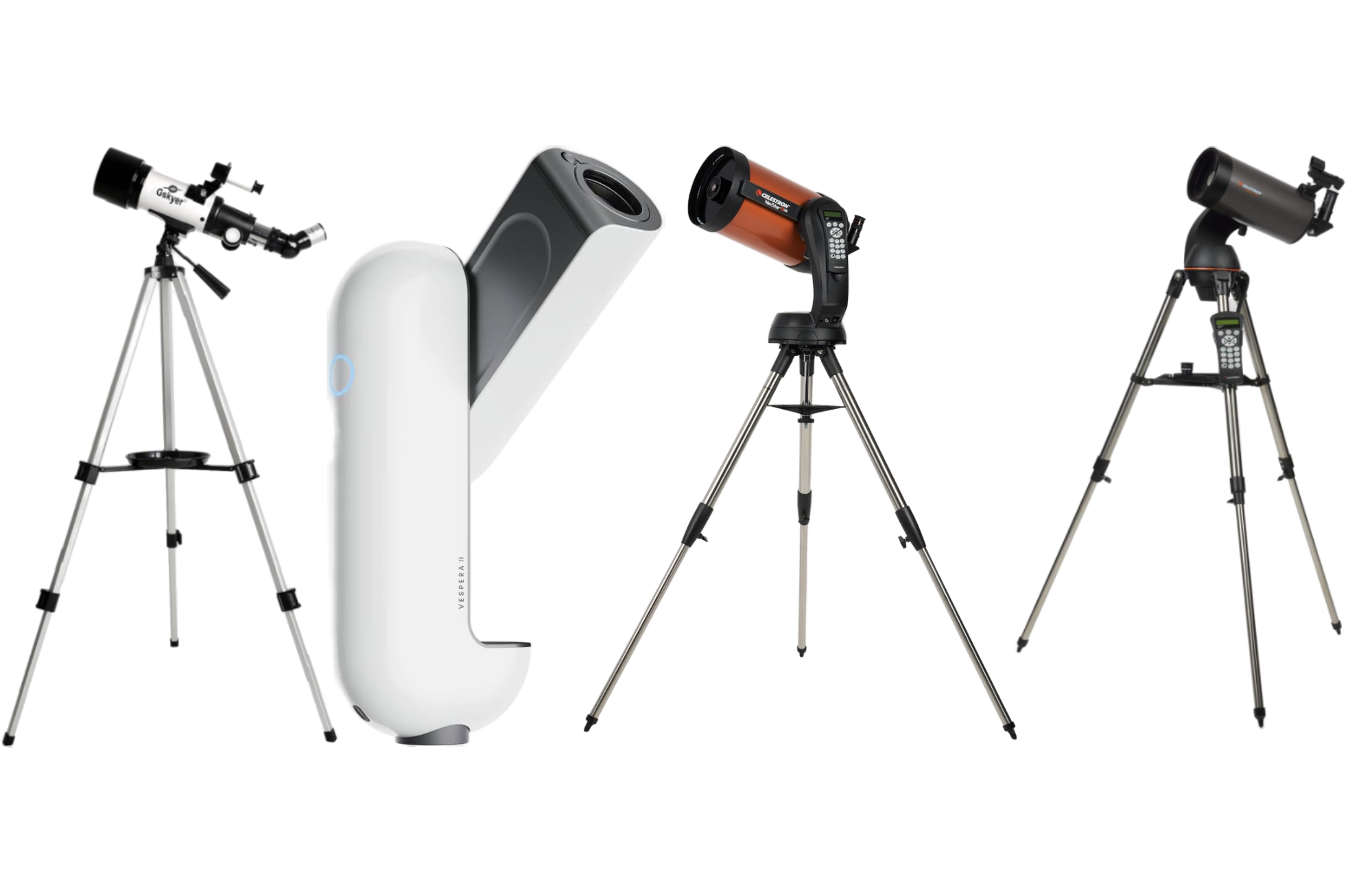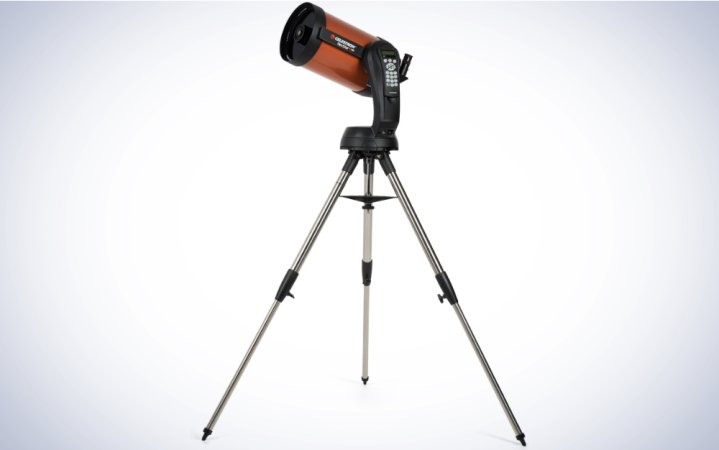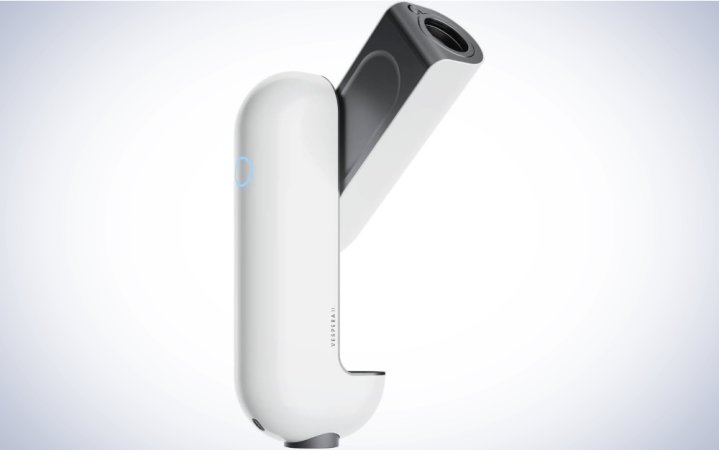Travel
The best travel telescopes of 2024

We may earn revenue from the products available on this page and participate in affiliate programs. Learn more ›
Viewing the night sky up close and personal with the help of a travel telescope is a magical experience. After all, many of us live in locations with far too much light pollution to fully enjoy the benefits of a telescope at home. A travel telescope lets you take the show on the road, seeking out dark sky areas. It can also help you share the magic of cosmic exploration with others. However, shopping for telescopes of any type can be overwhelming due to a plethora of technical jargon and complicated specifications. We’ve researched for you and identified the best travel telescopes—like our best overall, the Celestron NexStar 127SLT—so you can bring your love for surveying space wherever you go.
How we chose the best travel telescopes
Our selections for the best travel telescopes were based on extensive research and experience with astronomy experts. First and foremost, travel telescopes must be at least somewhat portable. As a result, we focused on telescopes that were relatively lightweight, compact, and durable. Optical quality was key, as even travel telescopes should provide a good viewing experience. Finally, we selected options with various apertures, focal lengths, magnification, and price points, making them suitable for various situations and users.
The best travel telescopes: Reviews & Recommendations
Like other varieties of telescopes, travel telescopes come in various sizes, shapes, and formats. Of course, opting for a smaller, travel-friendly design means making some sacrifices. Luckily, though, there are still plenty of telescopes worth investing in for your travels.
Best overall: Celestron NexStar 127SLT
Why it made the cut: Offering a surprising amount of magnification in a relatively lightweight package with computerized star tracking, the Celestron NexStar 127SLT packs a punch for a travel telescope.
Specs
- Weight: 18 pounds
- Dimensions: 15 x 38 x 54 inches
- Type: Maksutov-Cassegrain
- Mount: Altazimuth
- Aperture: 127mm
- Focal length: 1500mm
- Eyepiece: 9mm and 25mm
Pros
- Lots of magnification
- Relatively lightweight
- Offers computerized star tracking
Cons
One of the biggest downsides to travel telescopes is that they tend to be lower in magnification in order to keep a relatively compact size. The Celestron NexStar 127SLT, though, offers the best of both worlds. At 18 pounds, it’s not the lightest telescope available. But it features a 1500mm focal length and comes with 9mm and 25mm eyepieces. Those eyepieces result in 60x and 167x magnification, respectively. That level of magnification makes this quite the high-powered telescope compared to most travel telescopes.
Beyond lots of magnification, it offers a bright 127mm aperture. You’ll easily be able to see details like Jupiter’s clouds, Saturn’s rings, and craters on the moon. An added benefit for beginners is the GoTo technology and the database of more than 40,000 stars, galaxies, nebulae, and more. You can simply choose an object, and the telescope will find it and track it for you.
Setup is easy, taking only minutes with the included steel tripod. The primary mirror provides color-corrected views for high-quality results, making for a superb overall experience. Despite all its features, its price is very reasonable. Finally, it comes with a two-year warranty, giving you more confidence in traveling with this highly capable telescope.
Best handheld: Canon 15×50 IS Image Stabilized Binocular
Why it made the cut: The Canon 15×50 IS Image Stabilized Binocular provides the most portable form factor for stargazing with image stabilization to help while viewing handheld.
Specs
- Weight: 2.6 pounds
- Dimensions: 11 x 8 x 0.1 inches
- Type: Porro prism binoculars
- Mount: N/A
- Aperture: 50mm
- Focal length: N/A
- Eyepiece: N/A
Pros
- Compact and portable
- Useful for terrestrial viewing as well
- Image stabilization makes for easier handheld viewing
Cons
The Canon 15×50 IS Image Stabilized Binocular won’t give you the same view as a telescope, but if you want to stargaze in the backcountry, a pair of binoculars is the way to go. After all, you’ll never find a telescope that is as small or lightweight as these 2.6-pound binos. They will be much easier to pack into your backpack while still allowing room for all your other gear.
The Canon 15×50 IS binoculars are some of the best you can buy, too. The 50mm object lens diameter lets in a lot of light for binos. That’s the same aperture as the Vaonis Vespera II telescope and not much less than our budget travel telescope. They offer 15x magnification, enough to get a good view of the moon and some planets.
The image stabilization makes them even better, making it feasible to view the night sky while hand-holding the binoculars. For a better experience, you can also mount them to a monopod or tripod. The optics provide sharp, clear views with plenty of contrast, even in light-polluted areas. They are pricey but a great choice for stargazing on the go.
Best splurge: Celestron NexStar 8SE Telescope
Why it made the cut: The Celestron NexStar 8SE Telescope offers a large aperture, though magnification for planet viewing, and a high-quality view, making it worthy of its higher price.
Specs
- Weight: 32 pounds
- Dimensions: 32 x 34 x 52 inches
- Type: Schmidt-Cassegrain Catadioptric
- Mount: Computerized Altazimuth
- Aperture: 8-inch (203 mm)
- Focal length: 2032mm
- Eyepiece: 25mm
Pros
- Good light-gathering abilities
- Fully automated go-to mount
- Beginner-friendly
- High-quality viewing experience
Cons
- Narrow field of view
- Fairly heavy for a travel telescope
While the Celestron NexStar 8SE Telescope is a bit pricey, it’s far from the most expensive telescope on the market. We love this telescope because it balances quality, features, and price quite nicely. It’s a worthy splurge for those getting a bit more serious about astronomy and wanting to jump up to something with more quality.
The Nexstar 8SE offers a large, eight-inch aperture for lots of light gathering, making it ideal for scoping out deep celestial objects in deep space. The 2032mm focal length and 25mm eyepiece results in an 81x magnification, making it an excellent telescope to see planets. The optics are high-quality, resulting in sharp, high-contrast night sky views.
Beginner stargazers will appreciate the motorized go-to mount with a database of over 40,000 celestial objects. It’s easy to set up with the SkyAlign feature, so you can get to peeping the heavens right away. At 32 pounds, the NexStar 8SE is on the heavy side for a portable telescope. But, provided you don’t need to fly or hike with it, that weight is worth it, and the compact size makes it easy to pack into your car. For all these reasons, this is one of the best telescopes for adults willing to spend a little more.
Best smart: Vaonis Vespera 2
Why it made the cut: Weighing just 11 pounds, the Vaonis Verpera II smart telescope offers a uniquely sleek and portable design that’s easy to bring wherever you go.
Specs
- Weight: 11 pounds
- Dimensions: 21.7 x 13.2 x 6.2 inches
- Type: Not provided
- Mount: Computerized Altazimuth
- Aperture: 50mm
- Focal length: 250mm
- Eyepiece: N/A
Pros
- Simple to use
- Attractive and compact design
- High-quality, detailed astrophotographs
- Automatically cuts through light pollution
Cons
- Pricey
- Included tripod is rather short
There’s a lot to like about the Vaonis Vespera II. It offers quite a unique design for a telescope, with sleek, space-worthy looks in a highly compact package. It weighs just 11 pounds, and the included tripod is also quite small, so it’s easy to bring even if you are hiking in somewhere. If you don’t want to go far, the Vespera II features built-in light pollution filtering, making it easier to see the heavens even living in a city.
One of the main differences between the Vaonis Vespera II and traditional telescopes is that there is no scope. Instead of taking turns huddled over an eyepiece, you pair this smart telescope with a tablet or phone, making viewing celestial objects as a group easier. As a result, it’s also remarkably simple to set up and use, making it one of the best telescopes for beginners. You can control it entirely from your phone, selecting from 4,300 objects in the library to view, and the scope will automatically find and track that object.
The Vespera II offers a high-quality, clear view of the sky. When you like something you see, you can take an astrophotograph with a tap on your device, producing sharp images of up to 24 megapixels. The main downside is that it doesn’t provide much magnification, so it won’t be great for viewing planets or detailed shots of the moon. But for anyone who wants incredible simplicity in a compact package, you can’t beat the Vaonis Vespera II.
Best budget: Gskyer 70mm Telescope
Why it made the cut: Lightweight and affordable, the Gskyer 70mm Telescope is easy to travel with and just as easy to use.
Specs
- Weight: 5.64 pounds
- Dimensions: 24.8 x 4.92 x 8.46 inches
- Type: Refracting telescope
- Mount: Altazimuth
- Aperture: 70mm
- Focal length: 400mm
- Eyepiece: 10mm and 25mm
Pros
- Very lightweight
- Comes with a travel case
- Affordable
- Easy to use
Cons
The best budget telescope for travel also happens to be the most lightweight. Coming in at 5.64 pounds, this scope is easy to bring, no matter your mode of travel. Making things even easier is the included travel case, so you can keep all the separate components together and safe when you’re on the go.
This Gskyer telescope offers a 70mm aperture and 400mm focal length. It comes with a 10mm and 25mm eyepiece, providing 40x and 16x magnification. Those magnification levels give you more flexibility to view a range of objects in the night sky, from closeups of the moon to viewing the entire moon at once.
As a bonus, the Gysker 70mm Telescope has a smartphone adapter and a wireless camera remote so that you can take images through the scope with your phone. Of course, the budget price and lightweight design mean there are no smart or motorized features, so you’ll have to find objects in the sky on your own. And it won’t be powerful enough for epic planet views, either. But if you’re looking for a best value, it’s a good telescope and a great entry to stargazing on the go.
What to consider when buying one of the best travel telescopes
Shopping for a telescope can be quite confusing. There is a lot of technical jargon associated with these optical devices, and deciphering what it all means can be overwhelming. To help you sort through all the noise, below are some of the most important factors to pay attention to when shopping for a travel telescope (or any telescope, for that matter).
Size, weight, and portability
First and foremost, when shopping for a travel telescope, you’ll want to prioritize size and weight. Of course, just how small and light you need depends on the type of travel you’ll be doing. If you’re simply taking your car to a dark spot and don’t need to walk with the telescope very far, you could get away with a larger design. However, a compact, lightweight option is necessary if you want to fly with a telescope or even backpack with it.
Optical design
Broadly speaking, there are three different optical design types for consumer telescopes: refractor, reflector, and catadioptric. Each has advantages and disadvantages, depending on how it is used.
Refractor telescopes use lenses to allow light to travel in a straight path from the front lens to the eyepiece at the back of the scope. Refractors are easy to use, reliable, and require minimal maintenance. However, they are very long if you want a larger aperture and get expensive, especially for high-quality refractors.
Reflector telescopes use mirrors to reflect light, which allows for a much shorter design than reflector telescopes. They also cost less to make since mirrors are more affordable than quality glass, so more budget-friendly telescopes are reflector scopes. Dobsonian and Newtonian, two common types of telescopes, are both reflectors.
Lastly, catadioptric telescopes use a combination of lenses and mirrors, resulting in a compact body. Portable telescopes are typically catadioptric as a result.
Mount type
It’s easy to focus entirely on the optical portion of the telescope when shopping, but the mount is just as important. The telescope mount controls how and where the telescope can move, impacting what you can actually do with it. There are three types to consider: Alt-azimuth, Dobsonian, and equatorial.
Alt-azimuth mounts are the most affordable option available. They allow for vertical and horizontal adjustments and can enable smooth tracking across the sky. Some even allow for automatic tracking to take the work out of the process. As a result, they are ideal for shorter astrophotography captures.
Dobsonian mounts use a lazy susan-like platform that’s able to rotate. These platforms need to be placed on sturdy surfaces, though, like tables or mounted platforms. Dobsonian mounts provide more stability than other mount types, provided you have a stable surface for it. If you know you’re traveling somewhere that offers a stable, level table in an ideal location for a telescope, then it’s a worthy mount for a travel telescope. But if you’re bringing your telescope off the beaten path or to all sorts of locations, it would be best to opt for a different mount.
Lastly, equatorial mounts counteract the Earth’s rotation, making them best for long observations and astrophotography. With an equatorial mount, you can focus on a single celestial object and follow it—either manually or with an electric motor—across the sky while keeping it centered in the telescope.
Aperture
The telescope aperture is perhaps what most focus on when choosing a telescope. The aperture, also known as the primary lens, is measured by its diameter in either millimeters or inches. It indicates how much light the telescope lets in. A larger aperture will allow you to see dimmer objects, so it’s best to choose the largest lens you can afford. However, larger apertures also result in, naturally, larger telescopes. So you’ll also need to factor in how large of a telescope you want to travel with.
Magnification
You’ll also want to consider the type of objects you wish to view to decide which level of magnification is best. To see details like Saturn’s rings and Jupiter’s moons, a magnification of roughly 30 to 40x is necessary. For less detailed views, you can get away with less, however.
The focal length of your eyepiece partly determines magnification. Many telescopes, especially those for beginners, will come with at least one eyepiece or sometimes multiple for greater versatility. To calculate the magnification of a specific eyepiece, simply divide the focal length of the optical tube by the eyepiece.
Ease of use
Finally, some may appreciate extra telescope features that aid in using the scope. Many models today come with motorized mounts, including those with go-to functionality. Go-to mounts allow you to input a celestial object, and the telescope will automatically find and track it through the night sky. It takes much of the work out of stargazing, which some may appreciate and others may not. It also makes the telescope more expensive and heavier, so it’s essential to consider those tradeoffs.
FAQs
Simply put, travel scopes are, as the name implies, more travel-friendly than traditional telescopes. They are smaller, lighter, and often more durable than telescopes meant to stay put. Travel scopes typically don’t offer quite as good of a view of the heavens, though, so there is a tradeoff.
Depending on how up close and personal you want to get with the planets, a magnification between 30x and 40x will be ideal. A magnification that strong will help you see Jupiter’s moons and Saturn’s rings. If you want to see even closer, such as the ice caps on Mars, you’ll need a magnification of around 100x, though.
Yes, you can bring a telescope on a plane, provided it fits within the size limits of the airline you are flying. While you can put a telescope in checked baggage, that could be risky for your scope. After all, baggage handles aren’t always the most careful, and telescopes are typically delicate pieces of equipment. If it’s small enough, your best bet is to bring the travel telescope as a carry-on item in a protective case or bag.
Professional astronomers typically use reflecting telescopes, specifically the Ritchey-Chrétien design. These telescopes offer large diameters and well-corrected fields of view, allowing for superb image quality and plenty of reach for deep-space observations.
Final thoughts on the best travel telescopes
For many of us, traveling is the only way to get a quality view of the night sky since light pollution is becoming more significant. While telescopes can get quite bulky and heavy, plenty of options are lightweight enough to travel with to those dark sky locations. All the options included here offer a quality viewing experience in a portable package so you can take your stargazing on the go for an even better experience. From the well-rounded Celestron NexStar 127SLT to the smart Vaonis Vespera 2 and the budget-friendly Gskyer 70mm Telescope, one of the travel telescopes here will help you get epic views of celestial objects no matter what your preferred mode of travel.








.jpg)



